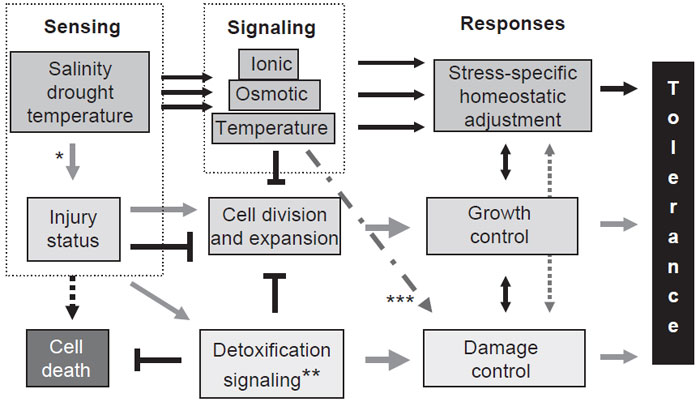Engineering Stress Response Control Determinants
However, one aspect that has to be considered in all engineering attempts is the effect of abiotic stresses on growth. Yeast and plants have been shown to include a signaling link that connects stress, the stress response, and growth retardation (Bressan et al., 2002; Hohmann, 2002; Zhu, 2001, 2002, 2003). As shown in Fig. 12.3, first outlined by Zhu (2001), abiotic stresses lead to typespecific responses (sos in the clearly documented case of salinity stress), but there are also general responses that extend beyond the specific elicitor. Most likely, these are responses to metabolic or hormonal deviations from a speciesspecific checkpoint or injury caused by the deviation in the form of, for example, ROS. It will require much work to address the dichotomy between protection and growth in the future.
 |
| FIGURE 12.3 Processes and mechanisms connecting abiotic stresses, injury, defense, and tolerance. Reactions to various abiotic stresses are seen as an integrated network of sensing, signaling, and downstream response pathways. Reactions are elicited that are stress factor specific. General responses are those that originate from the perception of metabolic imbalance and/or cellular injury. This leads to altered regulation of sets of genes that overlap several environmental stress conditions. Repression of cell cycle, growth, and development is seen as a consequence of additional hormone-regulated pathways (modified) (Bohnert and Bressan, 2001; Zhu, 2001). *Protein unfolding, membrane leakage, water/ion imbalance, ROS production. **General pathway distinct from the stress in functional categories of genes that are affected, and are not specific for a particular stress. Different stresses can elicit distinct isoforms (orthologues and paralogues) of genes in the same functional categories. ***Overlapping pathways that link specific stresses with individual genes that may be coregulated, or hyperregulated, by the specific condition and the general response. |




